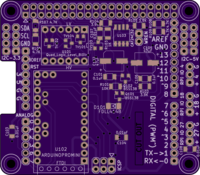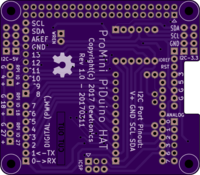ProMini PiDuino HAT
author: dewhisna
2 layer board of 2.56 x 2.23 inches (64.9 x 56.7 mm)
Uploaded:
March 12, 2017
Shared:
March 14, 2017
Total Price:
$28.50
The ProMini PiDuino HAT Board for the Raspberry Pi 3 allows mounting of an Arduino ProMini to a Raspberry Pi as a HAT. Functionally, this board is similar to an Alamode board but without real-time clocks, GPS interfaces, and servo breakouts that aren’t needed for most projects and it’s designed to actually fit the Pi without having to insulate things to keep it from shorting out.
The primary use is to breakout connections for I2C, both 3.3V and 5V ready, and tie the ATmega328 of the ProMini to the Pi as a coprocessor for real-time I/O processing without needing a real-time kernel on the RPi.
The ProMini can interface either via asynchronous serial or as an I2C-slave. The ProMini reset can be driven via GPIO17, allowing full Arduino programming of the ProMini directly from the RPi Host.
Three RPi GPIO’s are also broken out to direct-connect ports for use with interfacing things like single-wire hygrometers. And all GPIOs from the RPi that are used for I/O by this board are ESD protected.
It has a standard Arduino Uno R3 shield connector footprint for add-on boards.
It also supports the ID EEPROM as per HAT spec, but will work on older 26-pin RPi platforms too, sans the ID EEPROM.
The ProMini board was chosen because it’s actually more price effective than manually mounting the equivalent circuitry directly to this board. It also uses the off-the-shelf quad bi-directional logic-level converter, designed to stack above the ESD protection diodes that are mounted to this board, allowing a multilayer part configuration while keeping all parts top-side.
Happy Pi Day!
The ProMini PiDuino HAT Board for the Raspberry Pi 3 allows mounting of an Arduino ProMini to a Raspberry Pi as a HAT. Functionally, this board is similar to an Alamode board but without real-time clocks, GPS interfaces, and servo breakouts that aren’t needed for most projects and it’s designed to actually fit the Pi without having to insulate things to keep it from shorting out.
The primary use is to breakout connections for I2C, both 3.3V and 5V ready, and tie the ATmega328 of the ProMini to the Pi as a coprocessor for real-time I/O processing without needing a real-time kernel on the RPi.
The ProMini can interface either via asynchronous serial or as an I2C-slave. The ProMini reset can be driven via GPIO17, allowing full Arduino programming of the ProMini directly from the RPi Host.
Three RPi GPIO’s are also broken out to direct-connect ports for use with interfacing things like single-wire hygrometers. And all GPIOs from the RPi that are used for I/O by this board are ESD protected.
It has a standard Arduino Uno R3 shield connector footprint for add-on boards.
It also supports the ID EEPROM as per HAT spec, but will work on older 26-pin RPi platforms too, sans the ID EEPROM.
The ProMini board was chosen because it’s actually more price effective than manually mounting the equivalent circuitry directly to this board. It also uses the off-the-shelf quad bi-directional logic-level converter, designed to stack above the ESD protection diodes that are mounted to this board, allowing a multilayer part configuration while keeping all parts top-side.
Happy Pi Day!

